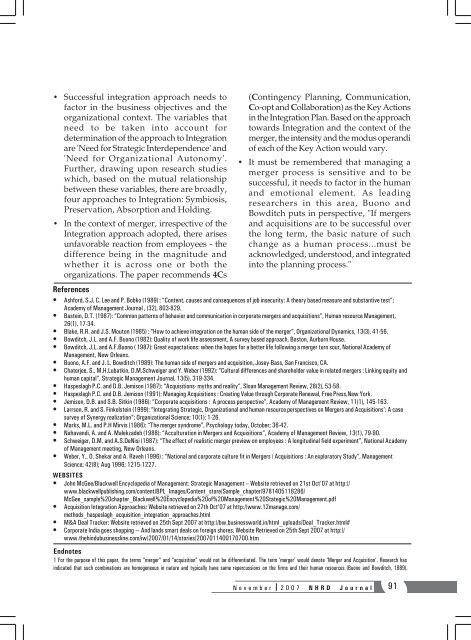NHRD Journal - National HRD Network
NHRD Journal - National HRD Network
NHRD Journal - National HRD Network
Create successful ePaper yourself
Turn your PDF publications into a flip-book with our unique Google optimized e-Paper software.
• Successful integration approach needs to<br />
factor in the business objectives and the<br />
organizational context. The variables that<br />
need to be taken into account for<br />
determination of the approach to Integration<br />
are 'Need for Strategic Interdependence' and<br />
'Need for Organizational Autonomy'.<br />
Further, drawing upon research studies<br />
which, based on the mutual relationship<br />
between these variables, there are broadly,<br />
four approaches to Integration: Symbiosis,<br />
Preservation, Absorption and Holding.<br />
• In the context of merger, irrespective of the<br />
Integration approach adopted, there arises<br />
unfavorable reaction from employees - the<br />
difference being in the magnitude and<br />
whether it is across one or both the<br />
organizations. The paper recommends 4Cs<br />
(Contingency Planning, Communication,<br />
Co-opt and Collaboration) as the Key Actions<br />
in the Integration Plan. Based on the approach<br />
towards Integration and the context of the<br />
merger, the intensity and the modus operandi<br />
of each of the Key Action would vary.<br />
• It must be remembered that managing a<br />
merger process is sensitive and to be<br />
successful, it needs to factor in the human<br />
and emotional element. As leading<br />
researchers in this area, Buono and<br />
Bowditch puts in perspective, "If mergers<br />
and acquisitions are to be successful over<br />
the long term, the basic nature of such<br />
change as a human process...must be<br />
acknowledged, understood, and integrated<br />
into the planning process."<br />
References<br />
• Ashford, S.J, C. Lee and P. Bobko (1989) : “Content, causes and consequences of job insecurity: A theory based measure and substantive test”;<br />
Academy of Management <strong>Journal</strong> , (32), 803-829.<br />
• Bastein, D.T. (1987): “Common patterns of behavior and communication in corporate mergers and acquisitions”, Human resource Management,<br />
26(1), 17-34.<br />
• Blake, R.R. and J.S. Mouton (1985) : “How to achieve integration on the human side of the merger”, Organizational Dynamics, 13(3), 41-56.<br />
• Bowditch, J.L. and A.F. Buono (1982): Quality of work life assessment, A survey based approach, Boston, Aurburn House.<br />
• Bowditch, J.L. and A.F.Buono ( 1987): Great expectations: when the hopes for a better life following a merger turn sour, <strong>National</strong> Academy of<br />
Management, New Orleans.<br />
• Buono, A.F. and J. L. Bowditch (1989): The human side of mergers and acquisition, Josey-Bass, San Francisco, CA.<br />
• Chaterjee, S., M.H.Lubatkin, D.M.Schweiger and Y. Weber (1992): “Cultural differences and shareholder value in related mergers : Linking equity and<br />
human capital”, Strategic Management <strong>Journal</strong>, 13(5), 319-334.<br />
• Haspeslagh P.C. and D.B. Jemison (1987): “Acquisitions- myths and reality”, Sloan Management Review, 28(2), 53-58.<br />
• Haspeslagh P.C. and D.B. Jemison (1991): Managing Acquisitions : Creating Value through Corporate Renewal, Free Press,New York.<br />
• Jemison, D.B. and S.B. Sitkin (1986): “Corporate acquisitions : A process perspective”, Academy of Management Review, 11(1), 145-163.<br />
• Larrson, R. and S. Finkelstein (1999): “Integrating Strategic, Organizational and human resource perspectives on Mergers and Acquisitions’: A case<br />
survey of Synergy realization”; Organizational Science; 10(1); 1-26.<br />
• Marks, M.L. and P.H Mirvis (1986): “The merger syndrome”, Psychology today, October; 36-42.<br />
• Nahavandi, A. and A. Malekzadeh (1988): “Acculturation in Mergers and Acquisitions”, Academy of Management Review, 13(1), 79-90.<br />
• Schweiger, D.M. and A.S.DeNisi (1987): “The effect of realistic merger preview on employees : A longitudinal field experiment”, <strong>National</strong> Academy<br />
of Management meeting, New Orleans.<br />
• Weber, Y., O. Shekar and A. Raveh (1996) : “<strong>National</strong> and corporate culture fit in Mergers / Acquisitions : An exploratory Study”, Management<br />
Science; 42(8); Aug 1996; 1215-1227.<br />
WEBSITES<br />
• John McGee/Blackwell Encyclopedia of Management: Strategic Management – Website retrieved on 21st Oct’07 at http://<br />
www.blackwellpublishing.com/content/BPL_Images/Content_store/Sample_chapter/9781405118286/<br />
McGee_sample%20chapter_Blackwell%20Encyclopedia%20of%20Management%20Stategic%20Management.pdf<br />
• Acquisition Integration Approaches: Website retrieved on 27th Oct’07 at http://www.12manage.com/<br />
methods_haspeslagh_acquisition_integration_approaches.html<br />
• M&A Deal Tracker: Website retrieved on 25th Sept 2007 at http://bw.businessworld.in/html_uploads/Deal_Tracker.html#<br />
• Corporate India goes shopping — And lands smart deals on foreign shores, Website Retrieved on 25th Sept 2007 at http://<br />
www.thehindubusinessline.com/iw/2007/01/14/stories/2007011400170700.htm<br />
Endnotes<br />
1 For the purpose of this paper, the terms “merger” and “acquisition” would not be differentiated. The term ‘merger’ would denote ‘Merger and Acquisition’. Research has<br />
indicated that such combinations are homogeneous in nature and typically have same repercussions on the firms and their human resources (Buono and Bowditch, 1989).<br />
November 2007 <strong>N<strong>HRD</strong></strong> <strong>Journal</strong> 91
















